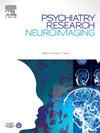神经性厌食症青少年对恐惧面孔的神经反应的纵向变化 - 一项 fMRI 研究。
IF 2.1
4区 医学
Q3 CLINICAL NEUROLOGY
引用次数: 0
摘要
目的:尽管神经元变化已被证实与神经性厌食症(AN)有关,但这些变化发生在何处以及在病程中如何变化往往并不清楚;情绪处理(如焦虑)方面的情况尤其如此,尽管越来越多的文献指出了情绪处理对神经性厌食症患者的病理生理学和临床病程的重要性:在急性饥饿期和短期体重恢复后对 22 名女性青少年 AN 患者进行了扫描,并与 27 名健康对照者进行了比较。在进行fMRI扫描时,采用了一种成熟的人脸匹配范式,涉及不同情绪的个体:结果:短期体重恢复后,当观察恐惧面孔时,选择性自闭症患者躯体运动皮层的神经激活明显增加。与健康对照组相比,或与中性、愤怒或惊讶面孔相比,均未发现差异。在急性饥饿期间,神经激活对恐惧面孔的反应与较低的 BMI-SDS 和较重的疾病负担有关:较高的躯体运动活动可能代表焦虑引起的运动反应准备(如战斗或逃跑),这在受影响较大的患者中更为明显。这些结果与最近的AN模型一致,这些模型越来越多地将焦虑纳入AN的病理生理学和预后模型中,并有助于阐明其潜在的神经机制。本文章由计算机程序翻译,如有差异,请以英文原文为准。

Longitudinal changes in neural responses to fearful faces in adolescents with anorexia nervosa – A fMRI study
Objective
Although proven neuronal changes are correlated with anorexia nervosa (AN), where these changes occur and how they change during the course of this disease are often unclear; this is especially true regarding emotion processing, e.g., of anxiety, despite a growing body of literature on its importance for the pathophysiology and clinical course of patients with AN.
Methods
Twenty-two female adolescent patients with AN were scanned during acute starvation and after short-term weight recovery and were compared to 27 healthy controls. A well-established face-matching paradigm involving individuals with different emotions was used during fMRI.
Results
Patients with AN selectively showed significantly increasing neural activation in the somatomotor cortex when viewing fearful faces following short-term weight recovery. No differences were found compared to healthy controls or for neutral, angry or surprised faces. Neural activation in response to fearful faces during acute starvation was associated with lower BMI-SDS and greater illness burden.
Conclusion
Higher somatomotor activity could represent anxiety-induced preparations for motor reactions (e.g., fight or flight) that are more pronounced in more affected patients. These results align with recent models of AN that increasingly incorporate anxiety into the pathophysiological and prognostic model of AN and help elucidate its underlying neurological mechanisms.
求助全文
通过发布文献求助,成功后即可免费获取论文全文。
去求助
来源期刊
CiteScore
3.80
自引率
0.00%
发文量
86
审稿时长
22.5 weeks
期刊介绍:
The Neuroimaging section of Psychiatry Research publishes manuscripts on positron emission tomography, magnetic resonance imaging, computerized electroencephalographic topography, regional cerebral blood flow, computed tomography, magnetoencephalography, autoradiography, post-mortem regional analyses, and other imaging techniques. Reports concerning results in psychiatric disorders, dementias, and the effects of behaviorial tasks and pharmacological treatments are featured. We also invite manuscripts on the methods of obtaining images and computer processing of the images themselves. Selected case reports are also published.

 求助内容:
求助内容: 应助结果提醒方式:
应助结果提醒方式:


